Imagine what it would be like if you didn’t have to worry about generating leads to fulfill your sales pipeline…all while you spend less time prospecting?
Imagine your profits were growing… you would have more time to work on your business and do all the things you wish you could do… you can spend more enjoying your business, heck even give yourself a bonus, or go on a holiday without worrying about making the next sale.
So ask yourself: are you sick of trying to guess how to grow your business? Are you frustrated by spending your money on advertising that does not work?
Well, you don’t have to feel like this anymore… Today I am writing this post to help you learn how to get a continual flow of leads & sales for your business.
We are in the business of…
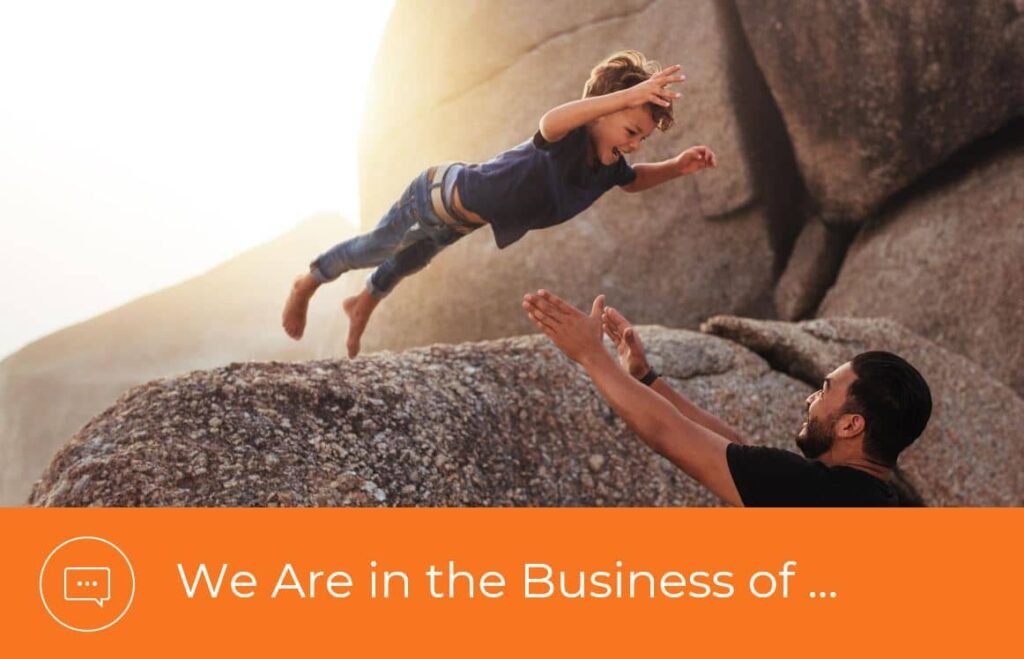
You have probably gone into business because you believe can do it better than anyone else!
If I asked every team member in your company “what business are you in” what would they say? Well, I imagine if they are a mortgage broker, they would say home loans; if they are an accountant, they’d say we’re into accounting, but the fact is, that’s not the business they’re in, that’s not the business you’re in.
Before I became a marketing guy, I ran a health magazine website. I wrote weekly, sometimes daily, on everything health-related from weight loss to muscle gain, healthy eating and relationship advice. If people believed me, they would buy what I was selling.
Within six months of starting the website, we went from no customers to 20,000 readers per day and $100,000.00 profit per year, all while I was studying at university. These results were all based on understanding the buyers (readers) and writing content that solved their problems and in most cases, I wrote out their desires & goals.
This is how I got in this world of marketing and sales. Marketing and sales have one thing in common with all businesses across the board – we’re all in the business of trust.
We’re in the business of trust
Imagine you become the most trusted voice in your space… Would you like to be the most trusted voice in your space?
The companies that are doing amazing things online these days are obsessing over the T-word: trust. They don’t worry about what the competition is doing, they worry about when someone visits their website, goes on their social media profile, when they talk to their team, what are they going to think or say?
You want your prospects & customers to think “they actually understand me and know how to solve my problems”… that’s the goal, right?
That’s the business we’re in… it is the business of trust. You’re in it, I’m in it, and the sooner you accept this fact, the faster you will progress.
Interestingly, I know a company who were losing in excess of 12-million a year (Imagine if that were you ). They recently employed a well-known trusted CEO, who was able to turn the business around from losing millions to making hundreds of millions within a few years purely because people trusted him and knew he would have their back – this leads me into the Trust Formula.
The Trust Formula
The trust formula is based on 4 elements: credibility, reliability, intimacy, and self-orientation.

The numerators all contribute to building trust – when assessing your trust – your customers are asking themselves:
- Are you credible?
- Are you reliable?
These two rational and analytical components are where most companies focus.
However, it is the emotional components which make the greatest impact, including:
- Intimacy, which is when someone feels safe and secure about someone; they believe you understand them.
The denominator in this formula is Self-Orientation, which is how much focus is on you opposed to your customer.
Generally, trust only opens up when you show intimacy (don’t use the word “intimacy” with your customers, they might run ), when they feel you truly understand their problems and desires.
Customer-Centric Trust Formula
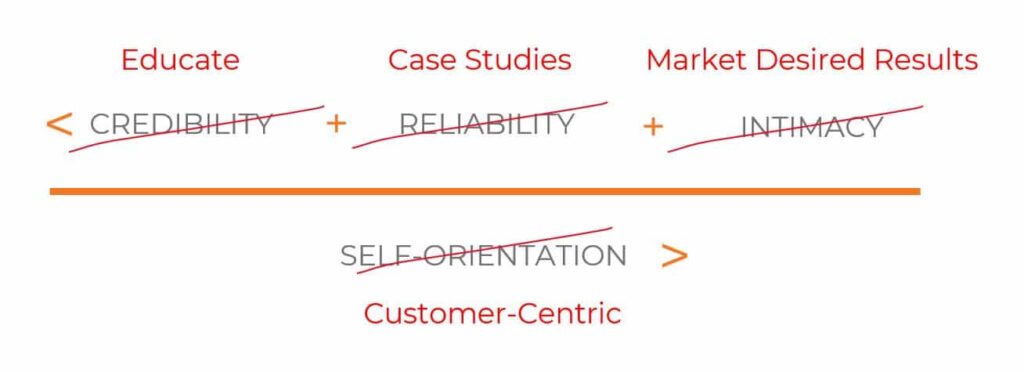
Now, when it comes to customer-centric marketing this formula is very important. When you start to educate the customer, you become credible. When you share case studies & testimonials, you become reliable. When you understand their problems & desires (Market Desired Results), you build intimacy. When you start to think in a customer-centric way, you lower your self-orientation.
Let’s explore this idea further by discussing the art of giving not selling.
Giving NOT Selling
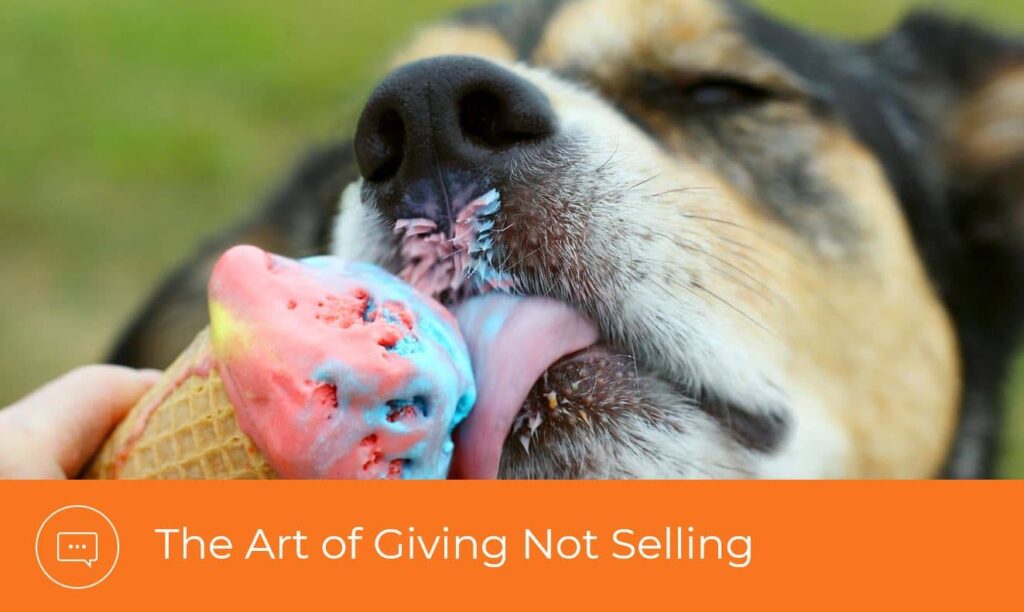
Imagine your sales cycle becomes faster and easier…
Over the years, I have come to realise this is possible but you need to approach the sale with the spirit of giving.
When you sense someone trying to sell something to you – let’s say someone trying to sell you a car – it can be quite off-putting, right?
But, if you come with the desire to give instead, then people become much more receptive and open to learn how you can help them solve their problems – this is when trust & co-operation start to evolve.
Regardless of what business or industry you’re in, when you come with the intention to give to help, it will make the whole process easier & faster.
From personal experience, I find it more effective not trying to sell. Personally, I don’t like pushing anything on anyone, so it becomes un-natural for me to sell, so I rather go into any conversation with the intention to help point them in the right direction – which may be our product or service – but I won’t do this until I know their actual needs. Focusing on giving rather than selling shapes our offering to provide customers with something they need.
Zero Moment of Truth (ZMOT)
This is game-changing. The “Zero Moment” is a term coined by Google in 2011.
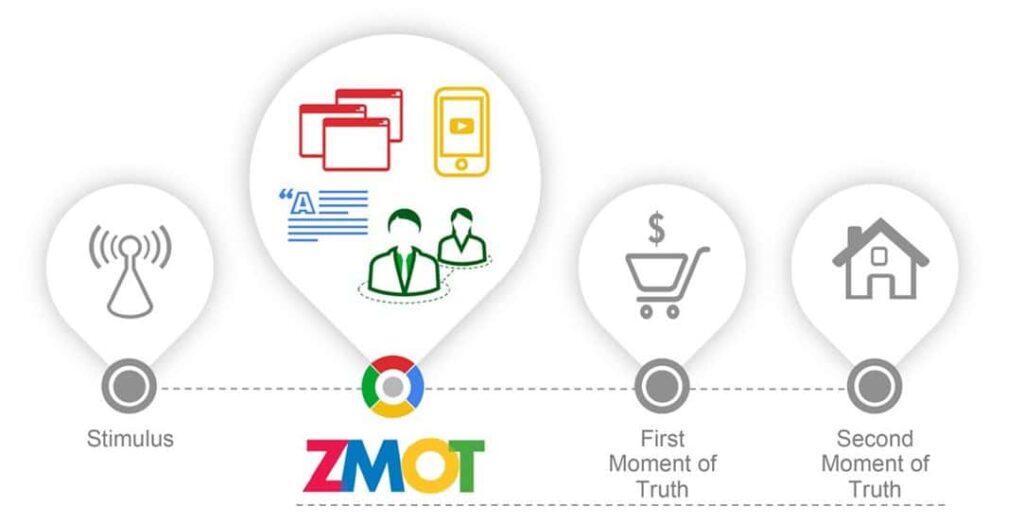
Typically, marketers have been using a three-step model of marketing – first being the stimulus like seeing a TV or Google Ad, then going to the store (first moment of truth) then take the product home to experience it – either being a good or a bad experience (second moment of truth).
Google did a comprehensive study with research partners with 5,000 shoppers across 12 categories from groceries to cars and financial products. The goal of the study was to show where influence takes place as shoppers move from undecided to decided. They found that the average customers used roughly 12 sources of information – up from 5 sources in 2010 – to help them make a decision.
They asked customers how they made their decision to buy a product/service, and they noticed there was a fourth-step which is called the ‘zero moment of truth’ – which is when your customers research alternatives, comparisons, reviews, coupons and educate themselves to become better buyers.
What was interesting in this study was that the ZMOT stage had the biggest impact and influence on the sale & experience than any other stage of the sales process.
Marketing vs Sales

Forrester research group, who is pretty much the most prominent research company, recently did a study that found that 57% of the of the buying decision is complete before customers contact the supplier/seller.
Before they talk to your team, fill out that form, call, office or store – they have made up 57% of their mind!
Based on the above statistics, which department of your business has a greater impact on the actual sale? Marketing or sales?
You are probably thinking marketing – I’m not here to say either is better, as I believe both can be more important and in many cases it depends on where you are within your business journey.
However, in tough times, marketing can be the first to be sacked, and in good times, sales are the first to be hired.
Why? In the past, we tied revenue directly to sales but now with have analytical or attribution tools that highlight the importance of marketing in the purchase decision.
Here’s my question for you: How many of your business’s current sales team know this study: that 57% of the decision is made up before they contact them? Does your sales team know the Zero Moment of Truth?
This is a huge problem. Don’t ever have another sales meeting in your business unless marketing is there; how are marketers meant to know your customers’ problems, desires, challenges, and questions that the salespeople are facing? Marketing can lay the seeds, give your sales team an advantage, while making the buying cycle faster and easier.
They ask, you answer

River Pools, a swimming pool company, was doing well. The economy was booming, people were spending money. Work was coming to them and it was difficult not to do well – sounds familiar to Perth’s mining boom, right?
In 2009, River Pools were in trouble; the economy had crashed, their bank account was overdrawn, they could not pay wages… imagine how stressful that would be!
They decided to do things differently, they decided to build credibility, reliability, intimacy, & become customer-centric.
How?
They answered their customers’ questions with a negative or positive light on their product. By using content marketing (blogging & videos) – they became the Wikipedia of fibreglass pools.
What was their process?
They brainstormed:
- What their customer was searching online?
- What were the questions they asked during the buying journey? Awareness, consideration, & decision stage
- Embraced content and inbound marketing to answer these questions.
What were the results?

River Pools become the most visited swimming pool website in the world. The SEO (keyword market share) was superior to their competitors. Check out their stats against their competitors… they almost have 200,000 visitors and growing – would you like to be in this position above your competitors?
The problem is most businesses simply aren’t obsessed with their customers questions, but the moment you become obsessed and then change your approach from facts & figures about your products and services, to instead answering their questions, you will build trust.
What’s your secret sauce?
Below is a Big Mac which is known for its secret sauce!

The biggest problem with most businesses is they think they have a secret sauce when in reality it’s nothing but Thousand Island dressing…
It’s true, McDonald’s want to build trust with their audience they answer the biggest questions “what is in the secret sauce that is in the Big Mac?”…
How do you think they responded to this question?
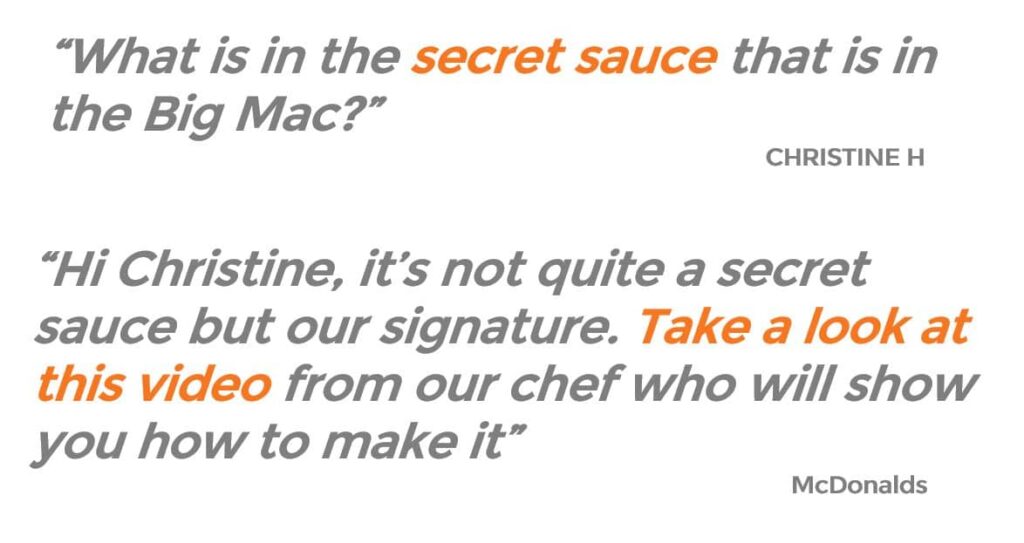
Do you think McDonalds is worried that we might invite all our mates over and then all of a sudden have a Big Mac convention at home? This is not going to happen…
Your customers want to know how you do what you do. You might be thinking this might be only for the big companies in fast food or corporate, etc. but I am here to say “you can do it too”, just like the local pool company.
Understanding your customer
You know how important it is to build trust but you need to put your customer at the forefront of you marketing and sales.
You need to understand your customers, paint the picture of the end results, and answer their questions.
Let’s get into how we can uncover these questions.
Firstly, we need to understand the 3 stages of the buying journey.
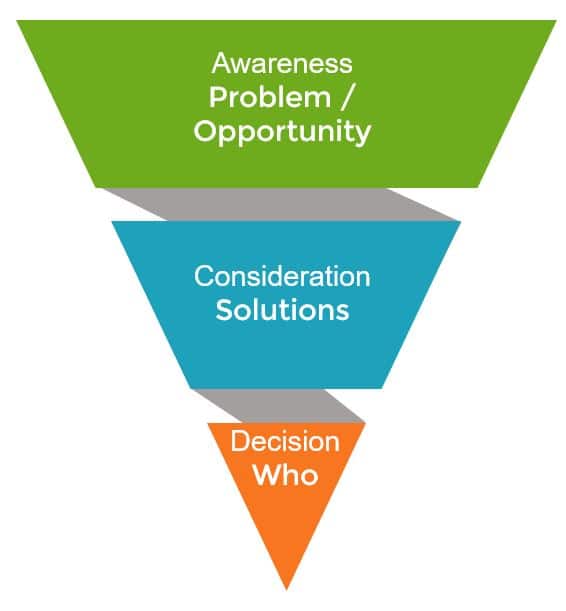
At the top, we have the awareness stage, where people are looking for answers to their problems or desires.
In the middle, we have the consideration stage, where they are researching the products or services which will solve those problems or desires.
Lastly, we have the decision stage, where people are figuring out who will solve their problem or desires.
We need to keep in mind that only 5% of people are ready to buy in the decision stage, yet the remaining customers are in the 95 percentile.
So we need to think outside the square and talk about their problems, desires, and solutions opposed to why your company and product/service are the best options.
Below is some example of customer questions at each stage:
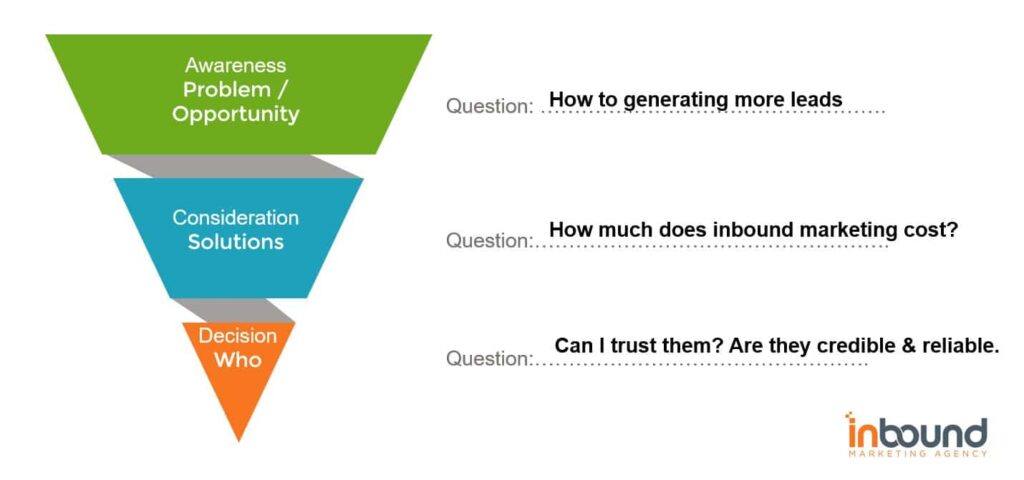
Now we have a few questions, we can look at the best ways to answer these questions using content & inbound marketing.
Wait… there is a step before
Often marketing agencies talk about the marketing channel such as Google or Facebook… Before understanding your goals and customers.
Here is a four-step strategy you need follow to ensure success:

- Self Assessment
Here you need to understand where you are now (online visibility, traffic breakdown by each source, conversation rate – btw a typically conversation rate is 2.35%, leads, cost-per-lead), marketing assets you have, and what are your growth goals and what metrics will have the greatest impact on your business.
- Buyer Personas
Here you will paint a clear picture of your target customer: what are their problems, goals, challenges and desired end result – and all their questions.
- Building the Engine
Here you will outline the engine for growth, how are you going convert them in qualified leads and nurture them into sales using marketing automation.
- Inbound Campaigns
Only at this stage is where you map out which channels you’re going to use & tactics. You will map out a detailed content plan to attract your target customer and answer their questions.
Customer-Centric Marketing Wrap-up
I love customer-centric marketing – being able to share useful information to help them solve their problems and desires. What I love the most about my job is that we can change someone’s life – taking people whose business are struggling, who are stressed, who have the pressure to support their team and family financially and being able to turn this around so they can focus on things they enjoy the most.
My question for you today is: What’s your secret sauce that’s holding you back from building your customer’s trust?
Become the teacher and embrace openness, become the trusted leader in your space and start giving. Are you with me?
FREE AI-Powered 1-Page Inbound Marketing Plan

